In today’s world, there are mainly two reasons someone chooses to own a dog.

The first is to serve as a companion or a family pet. Whereas the second is to raise a dog and get them to enter national and international competitions.
If you want a dog for the latter, their bloodline can be a significant factor when it comes to competing.

Read our Smart Poodles - Smart Tricks eBook for only $2.99
Dive into a treasure trove of engaging tricks and tips designed specifically for your poodle!
This is no different from a Poodle.
For a Poodle to compete in shows, they must be recognized by the American Kennel Club or any important Kennel club in their country. This means they can’t be one of the 40 different designer breeds, and both their parents must also have a good lineage.
To help expand your knowledge, today, I’m going to cover everything about the purebred Poodle.
What Will You Learn? 👇
How to tell if my Poodle is purebred?
To know if a Poodle is purebred, the definition needs to be broken down first. For a breed to be purebred, they have to be bred from parents of the same kind. Therefore, a purebred Poodle must have parents that are also purebred, alongside their grandparents and great great grandparents.
If you own a Poodle or thinking about owning one and you are not sure if they’re purebred, there are a few ways you can find out.
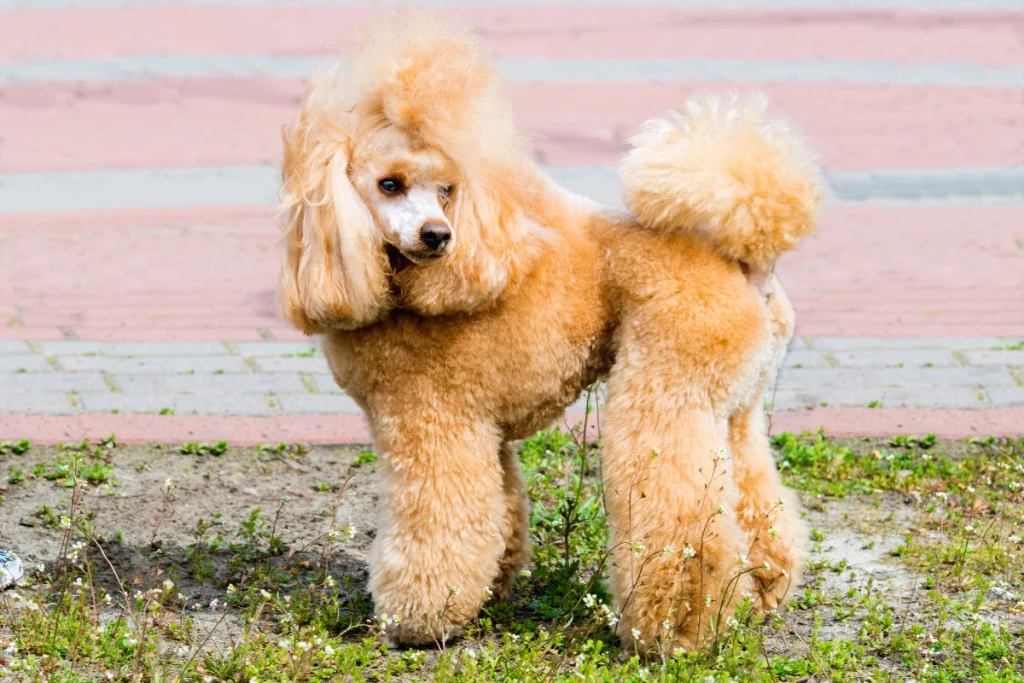
Breeder
One of the best ways to ensure a Poodle is purebred is by purchasing one from a purebred breeder. These breeders remain highly professional, take their job seriously and take a lot of pride in raising these dogs.
Some breeders strictly focus on specific types of purebred Poodles such as Standards, Miniatures, and Toys. Plus, these breeders tend to split the dogs into two distinct categories: show quality and domestic quality.
Plus, breeders who take pride in raising purebred Poodles will only sell to people once they’ve interviewed them and visited the owner’s home. So typically, when you speak to a breeder, you will have a good indicator if they’re raising a purebred, as they will usually be passionate about their breeding methods.
In comparison to backyard breeders or dogs from puppy mills, a purebred breeder will provide the following:
- Proof of vaccinations
- Medical records of the Poodles parents
- Proof of pedigree certificate
- Further support once purchased
- DNA/health certificates
Pedigree papers
Another way of identifying if a Poodle is purebred is by getting Pedigree papers. These papers will confirm if a Poodle has been registered and recognized by the American Kennel Club or the Kennel Club. So if you have one of these certificates to accompany your Poodle, then you can almost guarantee that they’re purebred.
DNA testing
If the breeder does not show proof of DNA, you can apply for a DNA test yourself. They’re so accessible you don’t even need to take your dog to a vet to do so. Nowadays, you can order them from big retail giants like Amazon and have results back in a matter of days. They’re a bit time-consuming but are incredibly cost-effective and tell you a lot of information about the Poodle’s ancestors.
What does a purebred poodle look like?
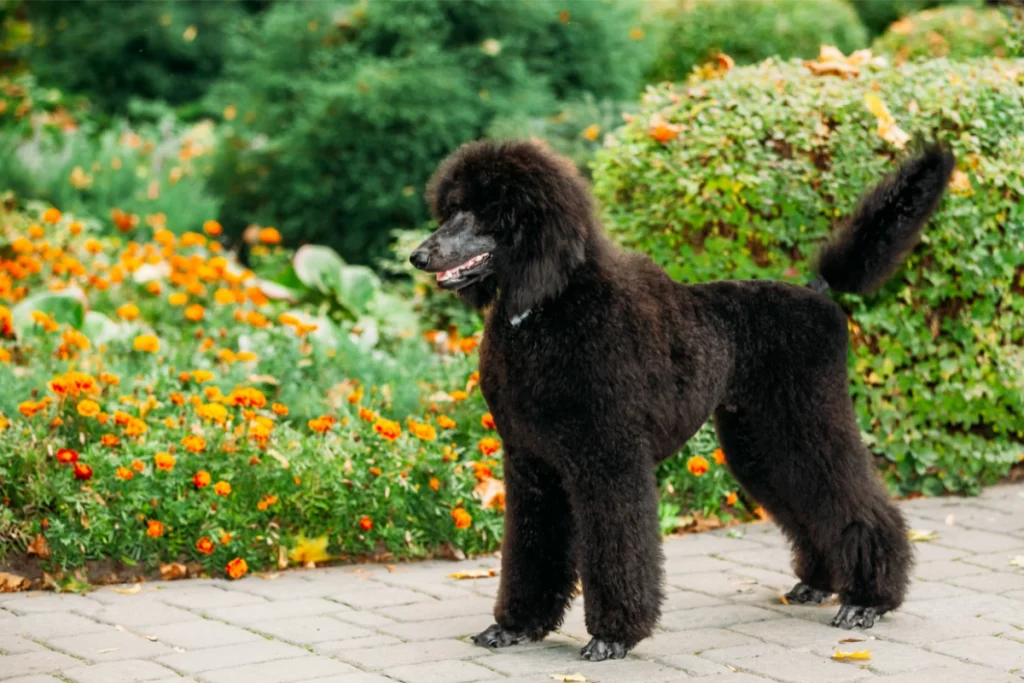
Another way of seeing if a Poodle is purebred is by comparing them to the breed standard. Generally, all Poodles have similar personalities; they are intelligent, active, and elegant. Purebreds also tend to have the following features:
Head: Most of the purebred time, Poodles have a slightly rounded head and a slight but significant stop.
Coat texture: One of the most specific qualities to detect in a purebred Poodle is its coat. A true purebred will have a nonshedding hypoallergenic coat. This means it is a fantastic dog for people who have allergies since they may cause less reactivity. A purebred will generally come in a blue, black, gray, white, silver, cream, brown, apricot, or café-au-lait coat. In addition to this, its texture will be curly and have dense, wiry hair.
Body: The Poodle has tight skin, which you will hardly ever see sagging. A purebred is also renowned for its strong, stocky, muscular body and shoulders. Their topline is even and does not droop down from their shoulder blade to the base of their tail.
In addition to this, they have a deep, broad chest, and their ribs are known to stick out a little. Plus, their groin area is short and muscular. A purebred also has a straight and high tail that is slightly docked.
The front half of their body: The forelegs of a purebred Poodle are straight and parallel to their other legs. Plus, when looking at the purebred Poodle from the side, their elbow is located just below the highest point of their shoulder. Moreover, they have small feet with arched oval-shaped toes and thick pads.
Back half of their body: When looking at a purebred Poodle from behind, their back legs should be straight and parallel. Plus, their femur and tibia bones should be equal in size.
Can purebred poodles be multicolored?
Just like I mentioned earlier, purebred Poodles can indeed come in a range of colors! However, Poodles that don’t have a solid color aren’t recognized as purebred as per the guidelines of the American Kennel Club. Well, at least they’re not allowed to compete in dog shows or recognized by specific classes.
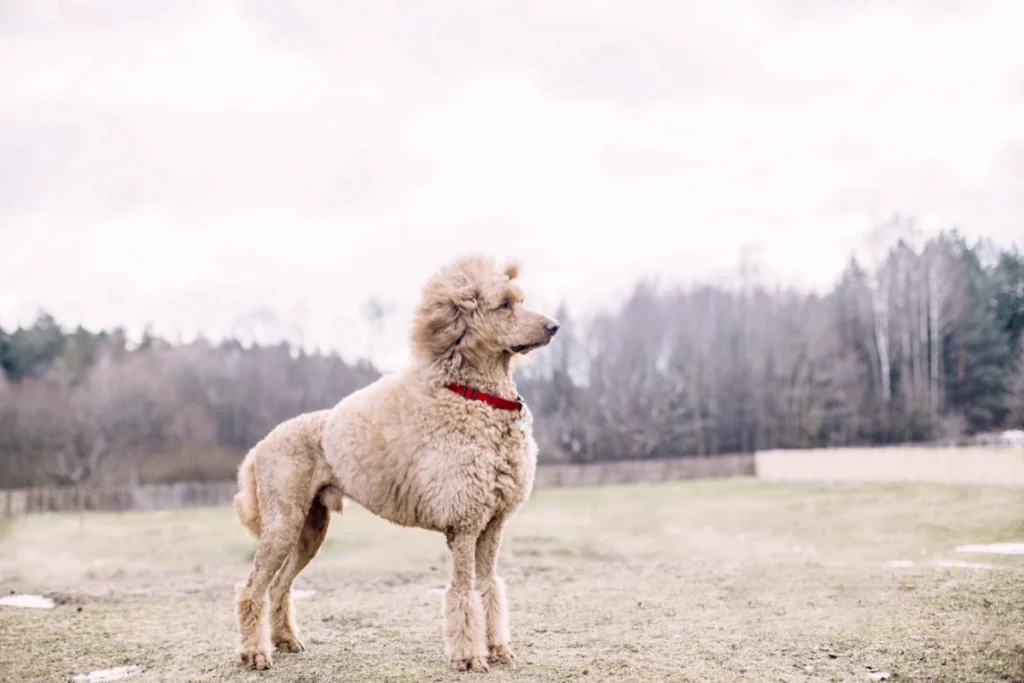
American Kennel Club (AKC) Standards
For purebreds to be recognized by the AKC, they must have solid colors in either black, white, cream, gray, blue, silver, brown, apricot, and “cafe-au-lait if they have any darker colors than this, especially at the tips of their ears and ruff.
United Kennel Club (UKC) Standards
Regarding purebreds, the UKC recognizes that Poodles can have a solid color, be parti-colored, or have an additional color with a least 50% white; abstract and another color with at 50% white and other colors on their body.
While the UKC recognizes purebreds can have this color, they don’t let Poodles of mixed colors compete against solid-colored Poodles in shows even though they’re not believed to be different breeds.
Looking at these two organizations, you might be slightly confused with purebred Poodles and their coat type. But, I say don’t just base a purebred on their coat type; always look for their papers and medical records to prove they’re a purebred.
Can purebred poodles have blue eyes?
Blue eyes are not limited to Doodles; in fact, purebreds can have them too, yet it’s uncommon. But, if you do notice a Poodle with blue eyes, you should start asking questions, especially to the breeder. Blue eyes are not the norm in a Poodle; the breed standard is actually brown eyes, as per the AKC.
A purebred with blue eyes can be a sign of underlying conditions, like the Merle gene, heterochromia, white irises, and Albinism.
- Merle gene: A genetic condition that can cause a different coat pattern and contribute to deaf and blindness.
- Heterochromia: A rare condition that can cause 2 different colored eyes.
- Albinism: A lack of melanin in their body causing blue eyes.
In addition to this, many scientists believe that blue eyes can only occur if a Poodle’s parents are not purebred and are across. However, there’s still a lot of research yet to be conducted to prove this. But, if you come across a Poodle with blue eyes, you should start asking the breeder questions and take it to a vet for further diagnosis.
How much do purebred poodles cost?
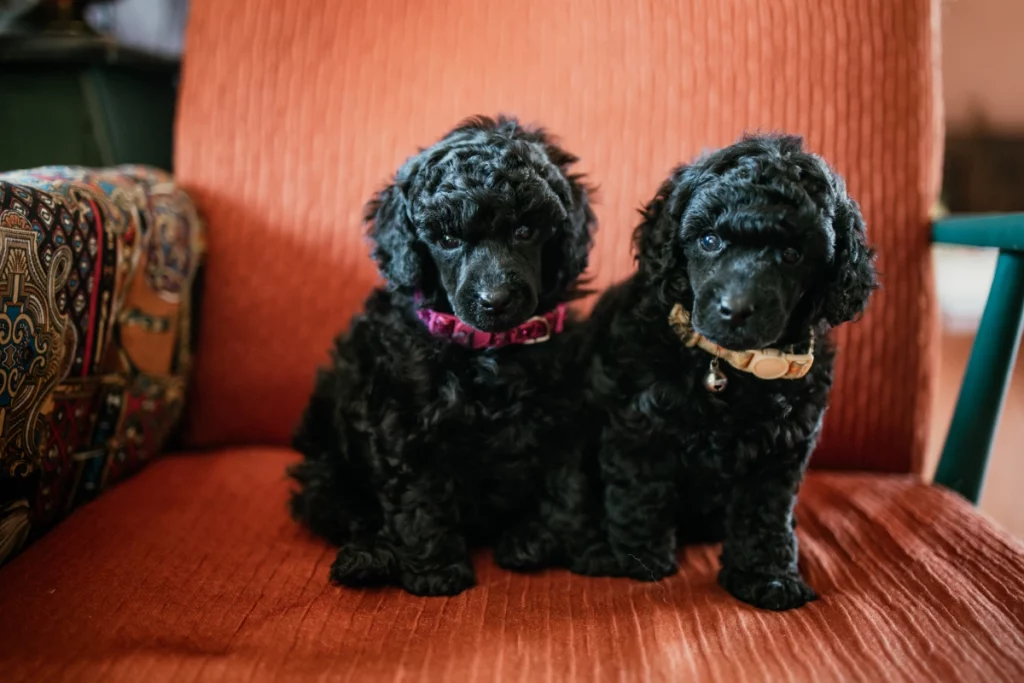
Another great tactic to determine if a Poodle is purebred is seeing how much a breeder charges. Usually, you will find how much is a poodle based on each breeder. Generally, though, you can expect to pay the same for trustworthy breeders.
But, also expect to pay more for a puppy that displays show qualities instead of a tame one. Those that are cheaper will generally have less of the AKC guidelines for coat color and appearance than a show standard. Plus, their temperament might be slightly different too.
You should also expect to pay more for smaller-sized Poodles like the Toy and Minature than Standard size. This is because smaller breeds produce smaller litters, making them difficult and more expensive for the breeder to breed.
Whereas the Standards produce large litters making it more manageable.
Given all this information, you can generally expect to pay $600-$1,500 for Standard Poodles. Then for Toy and Miniatures, they cost around $1,000-$2,000. Do note that external factors such as your location, breeder, and age of Poodle may influence the cost.
Where to Buy Purebred Poodles?
Like I mentioned previously, the best way to get a purebred is to go to a specialized breeder and ask for all those relevant documents. Of course, you can also go to a shelter or rescue organization and find one too. But, you should also be aware that this is not common, and it’s more likely you’ll get one from a specialized breeder.
Make sure you visit our list of breeders and read the list of questions you need to ask them before making a purchase.
However, you can also seek out specialist organizations that dedicate themselves to rehoming neglected Poodles; all it takes is a bit of research. Most of the time, these purebreds also cost lower than buying directly from a breeder. Ultimately, a breeder is the best option; just make sure you avoid puppy mills and visit the breeder in person.
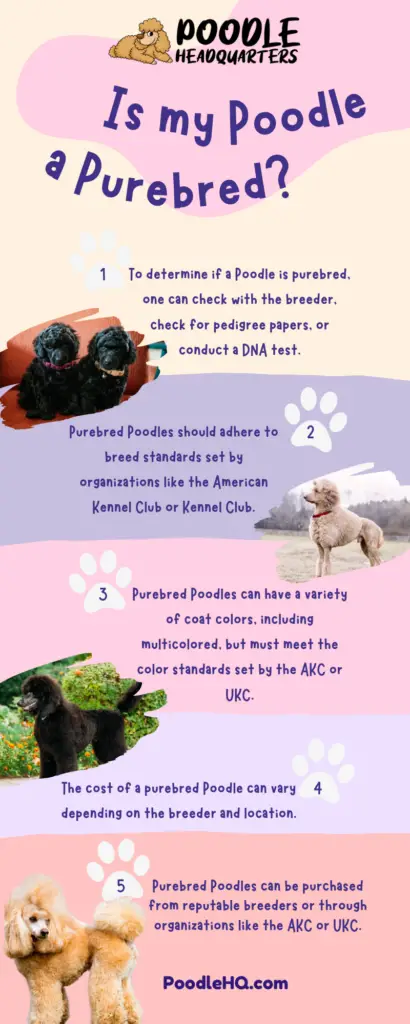
Conclusion
Overall, purebred Poodles can only be detected if you have proof of their DNA and pedigree certificates. However, if you buy one from a breeder that’s not been registered, you can always check for yourself by ordering a test kit online and applying for a registry by a kennel club.
Don’t always depend on their coat color, as different kennel clubs have different standards for a purebred. Do note, though, if you’re looking to buy one, you should visit a specialized breeder, look at the papers and see their behavior as an indicator before buying.
Often they will charge more for smaller breeds than standards due to their litter size. They will also be highly passionate about the purebred and may want to know more about your living style before selling the dog to you.
Do you feel you know a lot about the purebred Poodle now? If you have any additional questions, drop them in the comments below.
Marko is the founder and author at PoodleHQ, where he blends profound expertise with formal training in Animal Behavior and Canine Genetics. With multiple generations of poodles under his care, he’s a breed connoisseur, honored with the Canine Care Excellence Award and lauded by the International Pet Enthusiasts Association.

